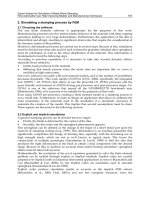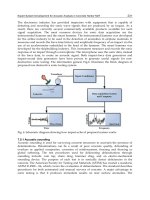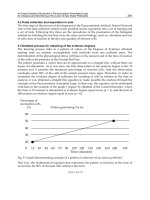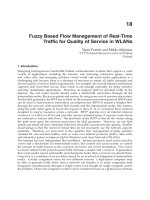Complex Robotic Systems - Pasquale Chiacchio & Stefano Chiaverini (Eds) part 9 pot
Bạn đang xem bản rút gọn của tài liệu. Xem và tải ngay bản đầy đủ của tài liệu tại đây (847.44 KB, 15 trang )
114 __
Chapter 4. Load distribution
and
control of interacting manipulators
that the kth column of A(=
~Tkj) = 06xl.
In this case, none of the
kinematic constraints in eq. (4.38) would be a function of the kth element
of the vector of joint velocities [a T,
aT] T.
Therefore it is further assumed
that each column vector comprising J has a nonzero component lying in
the null space of L.
Eq. (4.38) comprises six scalar constraint equations characterizing the
kinematic dependence among the joint velocities when the manipulators
operate in the closed chain configuration. Each independent scalar con-
straint contained in eq. (4.38) causes the loss of one position controlled
DOF in the closed chain [38]. Indeed, the number of positional DOF in the
entire closed chain system is (N1 + N2 - 6). This is significant because the
number of positional DOF specifies the number of independent ways that
the dual-manipulator closed chain system can move without violating the
constraints in eq. (4.38) .
A dynamical model for the multiple manipulator system in the joint
space is presented next.
4.5 Derivation of rigid body model in joint
space
The two manipulators and object form a single closed chain mechanism,
and a rigid body model governing the motion of the closed chain and the
behavior of the internal component of the contact forces is derived in the
joint space in this section. In the ensuing development it is useful to define
N12 = Ni + N2 •
The first step in deriving this model is to substitute for [fT, ]T] T in
eq. (4.2) using eq. (4.14) :
[ol 0Nlx ] [cl]
7" = ON2×N1 D2 q + Ca + dTo y + e
T T
where J is defined in conjunction with eq. (4.36) and where q = [qT q2 ] ,
• T T r T [TI T, rT] T.
Interestingly, it is
= [q T,q2] , q = [qT, q2] , and r =
observed that the coefficient matrix of e in eq. (4.40) is just the transpose
of the coefficient matrix of the vector of joint velocities in the kinematic
constraints given by eq. (4.38) .
Vector Y in eq. (4.40) is a function of the Cartesian space variables
{we, ~c, o)c} according to its definition in eq. (4.5) . Y can be expressed
in the joint space by substituting for wc and [~3~, &T] w in eq. (4.5) using
eq. (4.36) and its time derivative, respectively:
4,5. Derivation of rigid body model in joint space
115
- meg ]
r ++( ) [ 03×3, I3 ]+T++
(4.41)
In eq. (4.41) , the (12 x 6) and (12 x N12) matrices ~)[=
(O+/Oq)q]
and
J [=
(OJ/Oq)q],
respectively, are both functions of the variables {q, 4}.
The occurrence of wc on the right of eq. (4.5) has been replaced by
[03x3, /3] +T Jq in eq. @41) . The components
{wc:, wc~, wcz}
in ma-
trix f~ are expressed in the joint space using this transformation, so ~c =
f~c(q, q) in eq. (4.41).
Substituting for Y in eq. (4.40) using eq. (4.41) and rearranging terms
yield the closed chain dynamics in the joint space:
T = Dq + C + Hm 4 +
Hv +
ATe
(4.42)
The (N12 x N12) matrix D =
D(q)
in eq. (4.42) is the inertia matrix for
the entire system. It is defined by:
[ D1 0NI×N2 ] +
jT~A~T J
(4.43)
D = ON2xNI D2
Since D~ is positive definite, the first term to the right of eq. (4.43) is
positive definite. The second term to the right of eq. (4.43) is positive
semidefinite. Therefore D is positive definite because the sum of a positive
definite matrix and a positive semidefinite matrix is positive definite [37].
The (N12 × 1) vector C =
C(q, 4)
is defined by:
C "~- [ C1 ]C2
(4.44)
The (N12 × N12) matrix
Hm = Hm(q,
q) and the (N12 x 1) vector
Hi, = Hv(q, 4)
in eq. (4.42) are defined by:
Hm : jT+ A (@T~ + +T j)
(4.45)
[ -meg
] (4.46)
Hv = jT¢~
flcKc [ 03×3, 13 ]
+.Tjq
It should be mentioned that the closed chain dynamical model derived in
[32] is just a special case of eq. (4.42) with {~, ¢} defined by eqs. (4.13)
and (4.28) , respectively.
Eq. (4.42) accounts for the dynamics of all components of the closed
chain but does not satisfy the rigid body kinematic constraints in eq. (4.38)
. Indeed, eq. (4.42) , along with the time derivative of eq. (4.38) :
116 __
Chapter 4. Load distribution and control of interacting manipulators
Aq + diq = 06xl (4.47)
comprise a joint space model which governs the motion of the closed chain
dual manipulator system and the internal component of the contact forces.
The (6 x N12) matrix A [=
(OA/Oq)dl]
in eq. (4.47) is a function of the
variables {q, 4}.
The form of eqs. (4.42) and (4.47) has been obtained for a broad class
of constrained rigid body mechanical systems in [39, 40] using the method
of Lagrange undetermined multipliers [38]. However, it is very unclear
how the issues of dynamically distributing the load and relating e to the
internal contact forces would be addressed if the modeling techniques given
in [39, 40] were applied to the multiple manipulator closed chain considered
here.
To discuss the application of the joint space model to accomplish a for-
ward dynamics simulation of the system, it is useful to combine eqs. (4.42)
and (4.47) into a single equation:
D A T r
e - A c~ ] (4.48)
In the forward dynamics problem, the (N12 + 6) quantities {~, e} are un-
knowns and the joint torques T are specified. A symbolic solution for the
variables {~, e} based on eq. (4.48) can be obtained by inverting the coef-
ficient matrix of [~T,
ET] T
using inverse by partitioning [37]:
= D-1A (V C - Hm~l - H,,) -D-1AT(AD-1AT)-IA~I
(4.49)
~. : (An -1 AT) -1 {An -1 (T C - Urea - Hv) + ff~(~}
(4.50)
The solution for e in eq. (4.50) is based on the invertibility of the quantity
(AD -1 AT).
D -1 is positive definite because D is. Given that A has
full rank six,
(A D -1 A T)
is positive definite and therefore nonsingular. In
eq. (4.49) , A is a (N12 × N12) matrix defined by:
A = Ilv12 -
A T (AD -1 AT) -1AD -1
(4.51)
where, here again, N12 = N1 + N2 and
IN~2
signifies an (N12 ×N12) identity
matrix. By a mathematical observation, A is idempotent, i.e., A 2 = A,
and therefore singular, since the only nonsingular idempotent matrix is the
identity matrix [37]. It has been shown in our earlier work [33] that the
4.6. Reduced order model
117
rank of A equals the number of position controlled DOF in the closed chain,
i.e.,
rank{A} = N12 - 6.
While the joint space model is useful for understanding how the sys-
tem evolves with time in response to applied joint torque inputs, it is not
convenient for the controller design process. Indeed, the number of scalar
equations in eq. (4.48) (or in eqs. (4.49) and (4.50) , which may also be
viewed as a rigid body model) exceed the number of joint torque inputs.
However, it is important to note that there is a well specified solution for
7- based on the rigid body model. Since the rank of A equals (N12 - 6)
and D is positive definite, the rank of the coefficient matrix (D -I A) of T
in eq. (4.49) is also equal to (N12 - 6) [41]. Therefore an additional six
independent scalar equations that are linear functions of T are needed to
yield a well specified solution for the Nm joint torques T. The six equations
are provided by eq. (4.50) . Rather than attempting to design a model
based controller by solving eqs. (4.49) and (4.50) (or eq. (4.48)) for the
joint torques, we will derive a reduced order model and design a control
architecture based on it. This is discussed next.
4.6 Reduced order model
The joint velocities and accelerations form coupled sets of generalized ve-
locities and accelerations for describing the configuration of the closed chain
system, respectively. Linear transformations which express these variables
in terms of new independent generalized velocities and accelerations are de-
rived and then applied to eliminate {0, q} from the closed chain dynamical
equations given by eq. (4.42) in this section. Then, building on the seminal
work in [39], linear transformations are applied to eq. (4.42) to separate
it into two sets of equations. The sets of equations govern the motion of
the closed chain and the behavior of the internal component of the contact
forces, respectively.
A new vector variable ~ = [Vl, u2, , //N12-6] T referred to as the
pseudovelocity vector [42, 43, 40] is introduced. The pseudovelocity vector
is defined by:
= Bq (4.52)
where the ((N12 -6) × N12) matrix B =
B(q)
selected so that the composite
(N12 × N12) matrix U, defined by:
118 ~ Chapter 4. Load distribution and control of interacting manipulators
is nonsingular, where here again, A is defined in conjunction with eq. (4.38)
and N12 = N1 + N2.
It is convenient to partition the inverse of U into two matrices:
U -1 = [ T, F ] (4.54)
where T = T(q) is an (N12 x 6) matrix and F = F(q) an (N12 x (N12 - 6))
matrix. Eqs. (4.53) and (4.54) imply five matrix identities:
AT = Is
AF = 06×(N~2-6)
B T
= O(N12-6)x6
B F =
IN1~-8
T A + F B = INI~
(4.55)
The identity AF = 06×(N12-6) reveals that the column vectors com-
prising F lie in and span the null space of A. F can be determined by the
following procedure. Noting that A
= kI/T
J and L • = 06×6, six vectors
lying in the null space (of A) are given by:
jT (] jT)-I LT
If N1 N2 = 6, then the above set of vectors spans the null space
and is assigned to F. If one or both of the manipulators is kinematically
redundant, then (N12 - 12) additional vectors are needed to span the null
space. By a mathematical obserwation, (N12 - 12) is the dimension of the
null space of J, and any vector lying in the null space of J also lies in
the null space of A. The null space of J can be determined by the zero
eigenvalue matrix theorem [44].
All vectors lying in the N12-dimensional articular space may be ex-
pressed in terms of the following basis Z:
z = [ r ] (4.56)
It is straightforward to verify that T can be expressed in terms of this
basis:
T = A r (AAT) -1 - FBA r (AAT) -1 (4.57)
Eqs. (4.38) and (4.52) can be solved for the joint velocities:
4 = r (4.58)
4.6. Reduced
order
model
119
Differentiating eq. (4.52) with respect to time establishes the linear
relationship between the pseudoaccelerations and the joint accelerations:
= B~ + /}t) (4.59)
The ((N12 - 6) × 5/12) matrix/3 [=
(OB/Oq)(l]
in eq. (4.59) is a function
of the variables {q, q}.
Eqs. (4.47) and (4.59) can be solved for ~/:
= [T i + rB]r
(4.60)
where eq. (4.58) has been used. As a result, the matrices A [=
(OA/Oq)F u]
and/~
[=
(OB/Oq)r
u] in eq. (4.60) are now functions of {q, u}.
A solution for ~ may also be obtained by differentiating eq. (4.58) with
respect to time:
= FP + Fu (4.61)
where the (N12 × (Me - 6)) matrix F[=
(OF/Oq)F u]
is a function of the
variables {q, u}.
Eqs. (4.60) and (4.61) are mathematically equivalent because of the
following matrix identity:
= - [T.~i + r/~] F (4.62)
Eq. (4.62) is obtained by differentiating the identity: T A + F B =
IN12
with respect to time and postmultiplying the resulting equation by F.
Substituting for q in eq. (4.38) using eq. (4.58) yields the kinematic
constraint equation A F u = 06× 1, which is identically true since A F =
06×(N1~-6)- Therefore, the kinematic constraints at the velocity level axe
satisfied regardless of the values of the pseudovelocities when eq. (4.58)
applies. Likewise, substituting for {q, q} in eq. (4.47) using eqs. (4.58)
and (4.60) reveals that the kinematic constraints at the acceleration level
are also satisfied regardless of the values of {u, ~}. These findings lead to
the observation that expressing the closed chain dynamical model given by
eqs. (4.42) and (4.47) in terms of the pseudovariables results in eq. (4.42)
alone representing a rigid body model of the multiple manipulator system:
c- + A +r.]- "m)r (4.63)
The number of equations in eq. (4.63) equals the sum of the position
controlled DOF and the internal force controlled DOF in the closed chain
system.
120 Chapter 4. Load distribution and control of interacting manipulators
It is important to note that eq. (4.63) is still a nonlinear function of
the joint positions q, i.e., D = D(q), C = C(q, u), Hm = Hm(q, v),
and H, = H,,(q, v). Thus it is difficult to perform a forward dynamics
simulation of the system based on eq. (4.63) . However, as will now be
shown, performing a linear transformation on eq. (4.63) makes the resulting
set of equations valuable for controller design purposes.
Premultiplying eq. (4.63) by the nonsingular matrix IF, D -1 AT] T and
utilizing eq. (4.56) separates the model into two sets of equations gov-
erning the position controlled DOF and the internal force controlled DOF,
respectively:
(4.64)
A9 -1 ATe = AD -1 {T - C- Hv - gmFu} + AFu (4.65)
The (N12 -6) scalar equations comprising eq. (4.64) constitute the reduced
order equations of motion for the closed chain system. Vector variable e,
which parameterizes the internal force controlled DOF, has been eliminated
from eq. (4.64) which in turn is calculated as a function of the variables
(q, u, 7) using eq. (4.65) . Since D is positive definite and F and has full
rank (N12 -6), then (F T D F) is positive definite and therefore nonsingular.
(A D -1 A T) is positive definite and nonsingular by a similar argument given
below eq. (4.50) . Thus eqs. (4.64) and (4.65) can be solved for ~ and e,
respectively.
Given the separated form of the reduced order model, we can now pro-
ceed with the controller design. This is discussed next.
4.7 Control architecture
The problem considered is to derive a control law for the N12 joint torques
~- = [T T, TT] T SO that the variables {e, v} quantifying the internal contact
force- and position- controlled DOF can be controlled independently. This
can be accomplished by applying the control architecture proposed in [33]
to completely decouple eqs. (4.64) and (4.65). The composite control {~-}
is the sum of an (N12 x 1) primary controller r p and an (N12 × 1) secondary
controller 7 -s which are defined by:
T p =
÷ c ÷.v, (4.66)
T s = A TT; + DFT; (4.67)
4.8. Condusions
121
In eq. (4.67) , T] and ~-; are (6xl) and ((N12 -6)×1) vectors, respectively,
representing control variables to be determined.
The composite control
(T = 7 p + T s )
defined by eqs. (4.66) and (4.67)
is substituted into eqs. (4.64) and (4.65) . The resulting equations, under
the assumption of perfect knowledge of the nonlinear terms in the model,
leads to the closed loop system:
7-;, (4.68)
e T~ (4.69)
in which eq. (4.56) has been invoked. Derivation of eqs. (4.68) and (4.69)
is based on the quantities {(FTD F),
(A D -1 AT)}
being invertible. It was
shown earlier that these quantities are positive definite and therefore non-
singular.
Suppose ~-; is selected to servo the pseudovariable error, and ~-~ for ser-
voing the internal contact force error. Since eqs. (4.68) and (4.69) are
completely decoupled, the secondary controller components T; and T} are
non-interacting controllers for position and internal contact force, respec-
tively.
It was claimed in [33] that the control architecture T = T p + T s decou-
pled the control of the pseudovariables and an independent subset of the
contact forces, namely those imparted by manipulator 2. As shown here
in Example 1 of Section 4.3, the modeling procedure in [33] unknowingly
distributed the toad such that e = fc2, i.e., the contact forces imparted
by manipulator 2 are purely internal. The control law
(r = T p
"~- T s)
de-
fined by eqs. (4.66) and (4.67) in fact decouples the position- and internal
force-controlled DOF. The physical insight into the decoupling was first
identified in [34]. It should be mentioned that a similar decoupling control
architecture was developed independently by Wen et al. in [17].
4.8 Conclusions
The chapter has reviewed a method for modeling and controlling two se-
rial link manipulators which mutually lift and transport a rigid body ob-
ject in a three dimensional workspace. The system was viewed as a single
closed chain mechanism and it was assumed that there is no relative mo-
tion between the end effectors and object. A new vector variable e which
parameterizes the internal contact force controlled degrees of freedom was
introduced. It was defined as a linear function of the contact forces that
both manipulators impart to the object using eq. (4.9) . A family of so-
lutions to the dynamic load distribution problem was obtained by solving
122 __
Chapter 4. Load distribution and control o[ interacting manipulators
the object's dynamical equations and eq. (4.9) for the contact forces. The
motion inducing component of every member of the family was shown to
be identical. The internal component of the general load distribution solu-
tion was shown to contain two terms: {~ e} and
{- • M L T (L LT) -1 Y}.
Three choices for matrix M which transforms the contact forces to define
e in eq. (4.9) were suggested. Interestingly, the third choice caused the
latter internal force term to vanish and resulted in the motion inducing
and internal components of the solution being mutually orthogonal.
The kinematic coupling effects between the manipulators due to the
shared payload were modeled. First, the Cartesian velocity of the object at
its center of mass was expressed as a linear function of the joint velocities
of both manipulators. Then a set of six rigid body kinematic constraints
restricting the values of the joint velocities was derived.
A rigid body dynamical model for closed chain system consisting of
(NI + N2 + 6) second order differential equations was first derived in the
joint space. The upper (N1 + N2) equations in the model are the closed
chain dynamical equations. They were derived by substituting the load
distribution solution for the contact forces into the manipulators' dynamical
equations. The resulting equations are linear functions of the Cartesian
vector Y defined in eq. (4.5) . We proposed here a generalization of our
previous methods [32, 33] for expressing Y in the joint space where Y =
Y(q,
q, ~) becomes an explicit function of the matrix ~. Our previous
results can be obtained by specifying choices for • in eq. (4.41) .
The last six equations in the joint space model are the kinematic ac-
celeration constraints. By expressing the model in the pseudospace, it was
shown that these last six equations are satisfied regardless of the values of
the pseudovariables. Therefore the upper (N1 + N2) equations of the model,
when expressed in the pseudospace, comprise a rigid body model for the
system. Linear transformations were applied to the (N1 + N2) equations
in the model to obtain reduced order equations governing the motion of the
system and a separate set of equations governing the internal components
of the contact forces. Both sets are functions of the joint torques of both
manipulators, but only the latter is a function of e. The control architec-
ture originally proposed in [33] was applied to completely decouple the two
sets of equations comprising the separated form of the model. As a result,
the pseudovariables and the elements of e are controlled independently.
Acknowledgements
This research was sponsored by the Office of Engineering Research Program,
Basic Energy Sciences, U.S. Department of Energy, under Contract No. DE-
REFERENCES 123
AC05-96OR22464 with Lockheed Martin Energy Research Corporation.
The author wishes to thank Dr. Lynne E. Parker for encouraging the
continuation and completion of this research.
References
[1] K. Laroussi, H. Hemami, and R.E. Goddard, "Coordination of Two
Planar Robots in Lifting," IEEE Journal of Robotics and Automa-
tion, vol. 4, no. 1, pp. 77-85, February 1988.
[2] P. Chiacchio, S. Chiaverini, and B. Siciliano, "Direct and inverse
kinematics for coordinated motion tasks of a two-manipulator sys-
tem," Trans. ASME J. of Dynamic Systems, Measurement, and
Control, vol. 118, pp. 691-697, December 1996.
[3] R. Bonitz and T. Hsia, "Robust Internal Force-tracking Impedance
Control for Coordinated Multi-arm Manipulation - Theory and
Experiments" Robotic and Manufacturing Systems, (Proc. World
Automation Congress (WAC'96), May 28-30, 1996, Montpellier,
France) edited by M. Jamshidi and F.G. Pin; TSI Press Series,
pp. 111-118, 1996.
[4] R. Bonitz and T. Hsia, "The Effects of Computational Delays in Co-
ordinated Multiple-arm Manipulation Using Robust Internal Force-
based Impedance Control" Robotic and Manufacturing Systems,
(Proc. World Automation Congress (WAC'96), May 28-30, 1996,
Montpellier, France) edited by M. Jamshidi and F.G. Pin; TSI Press
Series, pp. 103-110, 1996.
[5] S. Schneider and R. Cannon, "Object Impedance Control for Co-
operative Manipulation: Theory and Experimental Results" IEEE
Trans. Robotics and Automation, vol. 8, no. 3, pp. 383-394, 1992.
[6] M. Uchiyama, T. Kitano, Y. Tanno, and K. Miyawaki, "Cooperative
Multiple Robots to be Applied to Industries" Robotic and Manu-
facturing Systems, (Proc. World Automation Congress (WAC'96),
May 28-30, 1996, Montpellier, France) edited by M. Jamshidi and
F.G. Pin; TSI Press Series, vol. 3, pp. 759-764, 1996.
[7] M. Uchiyama, X. Delebarre, H. Amada, and T. Kitano, "Optimum
Internal Force Control for Two Cooperative Robots to Carry an
Object", Intelligent Automation and Soft Computing, (Proc. World
Automation Congress (WAC'94), Maui, HI, August 14-17, 1994)
vol. 2, pp. 111-116, TSI Press Series, 1994.
124 Chapter 4. Load distribution and control of interacting manipulators
[8] M. Uchiyama and P. Dauchez, "Symmetric kinematic formulation
and non-master slave coordinated control of two-arm robots", Ad-
vanced Robotics, vol. 7, no. 4, pp. 361-383, 1993.
[9] P. Chiacchio and S. Chiaverini, "PD-Type Control Schemes For Co-
operative Manipulator Systems," Intelligent Automation and Soft
Computing, (journal) vol. 2, no. 1, pp. 65-72, 1996.
[10] O. Khatib, K. Yokai, K. Chang, D. Ruspini, R. Holmberg, and A.
Casal, "Cooperative Tasks in Multiple Mobile Manipulation Sys-
tems," Robotics and Manufacturing, (Proc. Sixth Int'l Symposium
on Robotics and Manufacturing (ISRAM'96), May 28-30, 1996,
Montpellier, France) edited by M. Jamshidi et. al., vol. 6, pp. 345-
350, ASME Press, 1996.
[11] D. Williams and O. Khatib, "Modeling and Control of Internal
Force Dynamics in Multi-Grasp Manipulation", Robotics and Man-
ufacturing, (Proc. Fifth Int'l Symposium on Robotics and Manu-
facturing (ISRAM'94), Maui, HI, August 14-18, 1994) edited by M.
Jamshidi et. al., vol. 5, pp. 735-741, ASME Press, 1994.
[12] P. Hsu, "Adaptive Internal Force Control of a Two Manipulator
System," Robotics and Manufacturing, (Proc. Fifth Int'l Sympo-
sium on Robotics and Manufacturing (ISRAM'94), Maui, HI, Au-
gust 14-18, 1994) edited by M. Jamshidi et. al., vol. 5, pp. 151-156,
ASME Press, 1994.
[13] P. Hsu, "Coordinated Control of Multiple Manipulator Systems",
IEEE Trans. Robotics and Automation, vol. 9, no. 4, pp. 400-410,
August, 1993.
[14] D.J. Cox and D. Tesar, "Development System Environment
For Dual-Arm Robotic Operations," Robotics and Manufacturing,
(Proc. Fifth Int'l Symposium on Robotics and Manufacturing (IS-
RAM'94), Maui, HI, August 14-18, 1994) edited by M. Jamshidi et.
al., vol. 5, pp. 61-66, ASME Press, 1994.
[15] D.J. Cox and D. Tesar, "Cooperative Dual-Arm Robotic Opera-
tions with Fixture Interaction," Intelligent Automation and Soft
Computing, (Proc. World Automation Congress (WAC'94), Maul,
HI, August 14-17, 1994) vol. 2, pp. 439-444, TSI Press Series, 1994.
[16] F. Caccavale and J. Szewczyk, "Experimental Results of Oper-
ational Space Control on a Dual-Arm Robot System," Robotics
and Manufacturing, (Proc. Sixth Int'l Symposium on Robotics and
REFERENCES 125
Manufacturing (ISRAM'96), May 28-30, 1996, Montpellier, France)
edited by M. Jamshidi et. al., vol. 6, pp. 121-126, ASME Press, 1996.
[17] J.T. Wen and K. Kreutz Delgado, "Motion and Force Control of
Robotic Manipulators," Automatica, vol. 28, pp. 729-743, 1992.
[18]
K. Kreutz and A. Lokshin, "Load Balancing and Closed Chain Mul-
tiple Arm Control," American Control Conf., Atlanta, GA, vol. 3,
pp. 2148-2155, June 1988.
[19]
I.D. Walker, R.A. Freeman, and S.I. Marcus, "Analysis of Motion
and Internal Loading of Objects Grasped by Multiple Cooperating
Manipulators," Int'l J. of Robotics Research, vol. 10, no. 4, pp. 396-
409, August 1991.
[2o]
I.D. Walker, S.I. Marcus, and R.A. Freeman, "Distribution of Dy-
namic Loads for Multiple Cooperating Robot Manipulators," J.
Robotic Systems, vol. 6, no. 1, pp. 35-47, January 1989.
[21]
F. Pfeiffer, "Cooperating Fingers - A Special Form of Cooperat-
ing Robots," Robotic and Manufacturing Systems, (Proc. World
Automation Congress (WAC'96), May 28-30, 1996, Montpellier,
France) edited by M. Jamshidi and F.G. Pin, pp. 639-643, TSI
Press Series, 1996.
[22]
W. Nguyen and J.K. Mills "Fixtureless Assembly: Multi-Robot
Manipulation of Flexible Payloads," Robotics and Manufacturing,
(Proc. Sixth Int'l Symposium on Robotics and Manufacturing (IS-
RAM'96), May 28-30, 1996, Montpellier, France) edited by M.
Jamshidi et. al., vol. 6, pp. 661-666, ASME Press, 1996.
[23]
M.E. Pittelkau, "Adaptive Load Sharing Force Control for Two-
Arm Manipulators," IEEE Int'l Conf. Robotics and Automation,
vol. 1, pp. 498-503, Philadelphia, PA, April 24-29, 1988.
[24]
Y R. Hu and A.A. Goldenberg, "An Adaptive Approach to Motion
and Force Control of Multiple Coordinated Robot Arms," IEEE
Int'l Conf. Robotics and Automation, vol. 2, pp. 1091-1096, Scotts-
dale, AZ, May 14-19, 1989.
[25]
Y. Nakamura, K. Nagai, and T. Yoshikawa, "Dynamics and Sta-
bility in Coordination of Multiple Robotic Mechanisms," Int'l J. of
Robotics Research, Voi. 8, No. 2, pp. 44-61, April 1989.
126
[26]
Chapter 4. Load distribution and control of interacting manipulators
Y.D. Shin and M.J. Chung, "An Optimal Force Distribution Scheme
for Cooperating Multiple Robot Manipulators", Robotica, pp. 49-60,
Vol. 11, Part 1, Jam-Feb. 1993.
[27] M.H. Choi, B.H. Lee, and M.S. Ko, "Optimal Load Distribution for
Two Cooperating Manipulators Using a Force Ellipsoid", Robotica,
pp. 61-72, Vol. 11, Part 1, Jan Feb. 1993.
[28] L.T. Wang and M.J. Kuo, "Dynamic Load Carrying Capacity and
Inverse Dynamics of Multiple Cooperating Manipulators", IEEE
Trans. Robotics and Automation, pp. 71-77, Vol. 10, no. 1, February
1994.
[29] X. Yun, "Modeling and Control of Two Constrained Manipulators",
Journal of Intelligent and Robotic Systems, pp. 363-377, Vol. 4,
1991.
[30] X. Yun and V.R. Kumar, "An Approach to Simultaneous Control
of Trajectory and Interaction Forces in Dual-Arm Configurations",
IEEE Trans. on Robotics and Automation, pp. 618-625, Vol. 7,
No. 5, Oct. 1991.
[31] M.A. Unseren, "Determination of Contact Forces for Two Manip-
ulators Mutually Lifting a Rigid Object Using a Technique of Dy-
namic Load Distribution, " Intelligent Automation and Soft Com-
puting (journal), Vol. 2, No. 1, pp. 49-63, 1996.
[32] M.A. Unseren, 'CA New Technique for Dynamic Load Distribution
when Two Manipulators Mutually Lift a Rigid Object. Part 1: The
Proposed Technique (pp. 359-365); Part 2: Derivation of Entire
System Model and Control Architecture (pp. 367-372)"; Intelligent
Automation and Soft Computing, Trends in Research, Development,
and Applications, (Proc. World Automation Congress (WAC '94),
August 14-17, 1994, Maui, HI) edited by M. Jamshidi, etc.; TSI
Press Series, 1994.
[33] M.A. Unseren, "Rigid Body Dynamics and Decoupled Control Ar-
chitecture for Two Strongly Interacting Manipulators," Robotica,
vol. 9, part 4, pp. 421-430, 1991.
press),
[34] M.A. Unseren, "A Rigid Body Model and Decoupled Control Ar-
chitecture For Two Manipulators Holding a Complex Object,"
Robotics and Autonomous Systems, Vol. 10, No. 2-3, pp. 115-131,
1992.
REFERENCES
127
[35]
J.Y.S. Luh and Y.F. Zheng, "Constrained Relations Between Two
Coordinated Industrial Robots For Motion Control,"
International
Journal of Robotics Research,
vol. 6, no. 3, pp. 60-70, Fall 1987.
[36]
M.A. Unseren, "An Approach to Modeling a Kinematicatly Re-
dundant Closed Chain System Using Pseudovelocities,"
Robotics
and Manufacturing,
(Proc. Sixth Int'l Symposium on Robotics and
Manufacturing (ISRAM'96), May 28-30, 1996, Montpellier, France)
edited by M. Jamshidi et. al., vol. 6, pp. 843-850, ASME Press, 1996.
[37] B. Noble and J.W. Daniel,
Applied Linear Algebra,
2nd ed.,
Prentice-Hall, Inc., 1977.
[38] H. Goldstein,
Classical Mechanics,
2nd edition, Addison-Wesley,
1980.
[39]
H. Hemami and F.C. Weimer, "Modeling of Nonholonomic Dy-
namic Systems with Applications,"
ASME J. of Applied Mechanics,
vol. 48, pp. 177-182, March 1981.
[40]
R.K. Kankaanranta and H.N. Koivo, "Dynamics and Simulation of
Compliant Motion of a Manipulator,"
IEEE J. Robotics and Au-
tomation,
vol. 4, no. 2, pp. 163-173, April 1988.
[41] D.T. Finkbeiner,
Introduction to Matrices and Linear Transforma-
tions,
3rd ed., W.H. Freeman and Company, 1978.
[42] F.R. Gantmacher,
Lectures in Analytical Mechanics,
USSR: Mir
Publishers, chap. 1, sec. 10, 1975.
[43]
H. Hemami, "A Feedback On-Off Model of Biped Dynamics,"
1EEE
Trans. Systems, Man, and Cybernetics,
vol. SMC-10, no. 7, pp. 376-
383, sec. IV, July 1980.
[44]
J.W. Kamman and R.L. Huston, "Dynamics of Constrained Multi-
body Systems," ASME Journal of Applied Mechanics, Vol. 51,
pp. 899-903, December 1984.
Chapter 5
Multi-fingered hands:
A survey
Humans have evolved as the dominant species on the planet in part because
of their skills in fine manipulation using their multifingered hands. In recent
years, there has been much activity in the design, analysis, and control of
artificial multi-fingered hands, and corresponding research in the area of
machine dexterity. This chapter presents a brief survey of these efforts,
and attempts to provide an extensive bibliography of the area.
5.1 Robot hand hardware
We begin with a brief review of the state of the art in robot hand hard-
ware. In the last fifteen years, significant progress has been made in the
development of dextrous robot end effectors, which previously were largely
constrained to variants of the parallel jaw gripper. Some specialized single
degree of freedom grippers have been successfully introduced. However,
these are largely limited to the case where the objects to be grasped are
in a small, well-understood set, and are not truly dextrous in the general
sense.
Some early three-fingered hands, such as the Jameson Hands [47] began
the trend of development of more sophisticated end effectors. Numerous
multifingered hands have since been built and successfully demonstrated,
notably the Salisbury hand [81, 102, 111] (Figure 5.1) and the MIT/Utah
hand [55, 109, 116] (Figure 5.2).
These two hands have become the standards for researchers involved in
robot hand algorithm development and laboratory experimentation, partic-
129









